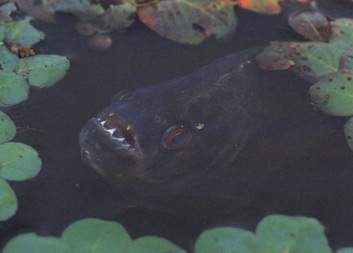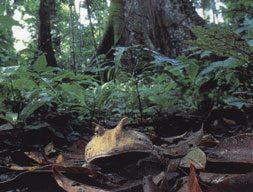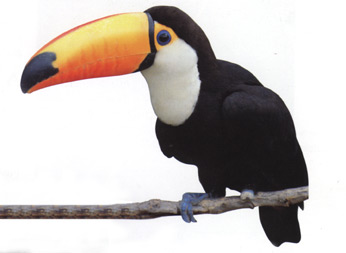|
|
Balas #18 HangPC2\ catat
kat sungai kelantan pernah wujud dolphin ni
-tp penduduk kg yg jahil, ambik senapang pg tembak, mati
-ni berlaku tahun 70-an, kesian sangat |
|
|
|
|
|
|
|
|
|
|
|
Reply #21 sekngucing's post
|
Dolphin air tawar sama macam kat Sungai Mekong kat Indochina.... |
|
|
|
|
|
|
|
|
|
|
|
Reply #18 HangPC2's post
peliknye rupa dolphin sungai.. |
|
|
|
|
|
|
|
|
|
|
|
the famous piranna..

The Amazon is home to the piranha, one of the world's most terrifying fish. Up to 60 centimetres long, piranhas hunt in shoals, or packs, and can kill cattle or humans and strip the flesh from their bones in afew minutes.
You wouldn't want one of these in your fish tank!
[ Last edited by rhys88 at 17-4-2009 18:39 ] |
Rate
-
1
View Rating Log
-
|
|
|
|
|
|
|
|
|
|
|
katak bertanduk amazon (hornfrog)

The rainforest atmosphere is so damp that a wide variety of frogs can thrive without living dose to rivers or streams. The huge horned frog is found only In The Amazon forest is the only place in the world where the Giant Horned Frog is found.
[ Last edited by rhys88 at 17-4-2009 18:40 ] |
Rate
-
1
View Rating Log
-
|
|
|
|
|
|
|
|
|
|
|
amazon anaconda..geli aku tengok..

An Anaconda at rest.
When it is hungry, it will uncoil itself and lie still in the water with only its eyes above the surface, waiting for prey.
Many stories are told about anacondas attacking fishermen, but it is rare for anacondas to attack humans unless they are being directly assualted or agitated |
Rate
-
1
View Rating Log
-
|
|
|
|
|
|
|
|
|
|
|

The toucan is found in the wild nowhere else in the world. Its huge beak, which can be as long as 20 centimetres enables it to eat large fruit. |
Rate
-
1
View Rating Log
-
|
|
|
|
|
|
|
|
|
|
|
Reply #23 rhys88's post
|
rupa macam zaman pra sejarah..... |
|
|
|
|
|
|
|
|
|
|
|
Reply #29 HangPC2's post
|
a'ah.. jangan2 dolphin sungai ni hidup sejak zaman pra sejarah tak.. |
|
|
|
|
|
|
|
|
|
|
|
The current creation of money out of thin air to give
to banks in the USA, Britain and some other nations
looks poised to trigger an enormous surge of inflation
before too long.
Never in history has such an avalanche of money been
created. More dollars for the same quantity of goods
means simply this: that the goods will rise in price
while the value of each dollar becomes less.
If I create 10 dollars to buy 10 pies, then there is one
pie for each dollar. But if I create 10 more dollars but
with no increase in the number of pies, then each pie is
now equal to 2 dollars.
The value of each pie has risen in dollar terms – and by
comparison the value of each dollar is now less. That is
what we mean by inflation.
Now relate that to the limited quantity of gold in the
world - which is in high demand - and you can understand
why the price of gold will soon take off like a rocket.
At present every little ounce of gold is worth around
$US910. Economists are predicting prices very soon will
soar to $1200 - or even $2500 or more - for each ounce.
No wonder there's a secret gold rush going on in the
remote Amazon jungle.
GLOBAL CRISIS SPARKS
GOLD RUSH IN BRAZIL'S AMAZON
Raymond Colitt reports from Brazil that many of
the country’s hundreds of thousands of miners risk
malaria and mercury poisoning only to squander their
earnings on gambling and prostitutes.
Pedro Ferreira spends his days and nights in a cramped,
steamy tunnel under the damp earth of the Amazon rain
forest, chipping away at a wall of rock glittering with
traces of gold.
He is one of nearly 1,000 wildcat miners who made a
five-day boat journey to this remote jungle site to dig
for gold — more highly prized now than ever as
international investors flocking to the metal as a safe
haven in the global financial crisis.
“With rumors of a new discovery and the high price of
gold, I came straight here,” said Ferreira, 34, wearing
a soiled tracksuit and resting on a pickax after emerging
from a hole in the ground at the Bom Jesus mine on the
upper Tapajos River.
The global crisis has revived this and other wildcat mines
in Brazil where hundreds of thousands of desperate workers
toil in precarious conditions, damaging their health and
the environment.
In the Tapajos Valley the number of miners has jumped
about 40 percent to 30,000 since October, coinciding with
a sharp rally in the price of gold to nearly US$1,000 an
ounce earlier this year before retreating to about US$890,
triggering a local economic boom as they spend their
bounty.
“It’s fueling our commerce. I don’t know what we’d do
without mining,” said Seme Sefrian Junior, an official in
Itaituba, a town 450km east of Manaus.
The falling prices of other commodities that Brazil relies
on helped push many to Bom Jesus, which means Good Jesus.
Antonio Souza Oliveira, dressed in shorts and sandals in
the tropical heat, left his 70 head of cattle to dig for gold.
“Raising cattle no longer pays — this is what puts my kids
through school,” said a smiling 47-year-old Oliveira, pointing
at a glittering piece of rock.
The price of beef, of which Brazil is the world’s biggest
exporter, has fallen 18 percent from nearly a year ago.
Critics say wildcat mining is more of a curse than a blessing
in a region where lawlessness thrives.
Working conditions are subhuman. Local strongmen take the bulk
of the profit and enforce their rules with a gun. Disease,
prostitution and environmental destruction abound.
With its foray onto global markets in recent years, Brazil has
come under increasing international scrutiny for the social
and environmental impact of its main exports. Wildcat mining
is the kind of negative publicity authorities could do
without.
“It is one of the wounds of the Amazon,” said Roberto
Mangabeira Unger, minister for strategic affairs, who is in
charge of a sustainable development plan for the region.
“It’s like serfdom but we won’t try to hide it.”
From the air, Bom Jesus is a mosaic of the forest’s green
canopy dotted with blue, yellow and black plastic sheeting
covering make-shift dormitories strung with hammocks.
A simple grocery store on one side of the bumpy landing strip
that divides the camp offers eggs, oranges and smoked sausage.
There are five bars and two “cabarets,” a euphemism for a
brothel. Besides a handful of prostitutes there are few women
in the camp, mostly cooks.
With luck, miners can make around 5,000 reais (US$2,272) a
month, more than 10 times more than the 465 reais a mason
earns.
A local middleman buys the gold they mine and traders in Sao
Paulo funnel it to local and world markets.
But many miners gamble and drink away their small fortunes.
“We work during the day to spend our money at night,” said
Guto Alves da Souza, whose laugh reveals a nearly toothless
mouth and emits a stench of smoke and cachaca, a local liquor
distilled from sugarcane.
After 30 years digging for gold, the 46-year-old has no
savings.
As many as a third of the miners have malaria, a deadly
disease if untreated.
Junior Alves de Goes, aged 43, squirms and moans in his
hammock from a high malarial fever. If he survives, he’ll
have a debt of 1,000 reais (US$449) for food and transport.
“It’s a gamble — you can make it big or end up like me,”
he said.
Images of the slave-like working conditions in which haggard,
mud-drenched miners carried bags of earth on their shoulders
at the Amazon’s Serra Pelada mine became world famous through
Brazilian photographer Sebastiao Salgado.
At Bom Jesus, miners lug buckets of rocks and earth by hand
through narrow tunnels that risk collapsing.
Teams of around four miners get only 35 percent of output,
while their bosses, who pay for equipment and transport, take
a 45 percent cut.
Valmir Climaco, a cattle rancher and logger, says he owns the
entire complex, even though the land belongs to the state. He
takes the remaining 20 percent cut of output and has a
monopoly on selling fuel, power and some foods at inflated
prices.
“If anybody crosses him, he pulls out his gun,” one woman in
Bom Jesus whispered. “But don’t say I told you.”
Some miners end up accumulating debt, which they work off as
if they were indentured servants.
“It’s a jungle prison,” said Jose Geraldo Torres, a national
legislator for the Amazon state of Para.
The government says there are 200,000 wildcat miners in Brazil
but experts say there may be twice as many, mostly illegal.
Authorities try to get them to form cooperatives and comply
with environmental regulations.
But in Bom Jesus the occasional visit from an official does
little to impress the 1,000 desperate miners.
Despite warnings, they still work with highly toxic chemicals
like mercury to amalgamate crushed iron ore. The runoff flows
into the river.
“There isn’t a federal police post for a stretch of nearly
1,000 kilometers in eastern Para. To have rule of law, you
need somebody to enforce it,” Torres said. |
|
|
|
|
|
|
|
|
|
|
|
Tujuan asal thread ini adalah berkenaan Lost City dalam hutan Amazon?
Ada logik asasnya sebab ramai orang 'Melayu' yang bertempiaran lari daripada Atlantis sampai ke Amerika Selatan |
|
|
|
|
|
|
|
|
|
|
|
Amazon adalah sebuah sebutan. Ada dua versi kontroversi mengenai maknanya jika ditinjau dari etimologi-nya.
Versi pertama, Amazon berdasarkan tinjauan bahasa Iran kuno kira-kira berbunyi 揫i]ha-mazan |
|
|
|
|
|
|
|
|
|
|
|
Balas #33 tutankhamun!\ catat
|
ada tertengok baru-baru ni kat cenel nat geo pasal amazon.. jumpa tinggalan kat stepe rusia |
|
|
|
|
|
|
|
|
|
|
|
Pahlawan wanita dari kelompok nomaden Scythia-Sarmatia yang menduduki kawasan-kawasan Rusia dan Siberia Barat menjadi sumber inspirasi sebuah legenda Yunani iaitu Legenda Amazon.
Agama-agama awal bangsa ini pula ialah Zoroastrianisme dan Manichaeisme. Zoroastrianisme nie agama Majusi. Agama asal kaum Arya .
Sebab tu peninggalan arkeologi suku kaum primitif Amazon nie telah dijumpai sekitar Rusia,Timur Tengah dan Asia Tengah |
|
|
|
|
|
|
|
|
|
|
|
The arapaima, pirarucu, or paiche (Arapaima gigas) is a South American tropical freshwater fish. It is one of the largest freshwater fishes in the world.
 |
Rate
-
1
View Rating Log
-
|
|
|
|
|
|
|
|
|
|
|
menariknya...tepek laa picture lagi frens... |
|
|
|
|
|
|
|
|
|
|
|
Reply #32 WonBin's post
|
Apa nak buat..dah tajuk dia 'apa ada dalam hutan amazon'...so dalam hutan amazon ada anaconda, piracuru, piranha, macaw, toucan, jaguar etc etc..... |
|
|
|
|
|
|
|
|
|
|
|
|
zaman dulu ada orang makan orang......zaman sekarang dah x mkn orang kot. |
|
|
|
|
|
|
|
|
|
| |
Category: Belia & Informasi
|